Advanced filters
In the Advanced filters window, you can set the conditions for filtering the rows in the translation editor.
memoQ will show those rows that meet the conditions.
How to get here
- Open a project.
- Open a document for editing.
- At the top of the translation editor, click the Advanced filters
 icon.
icon.The Advanced filters window opens.
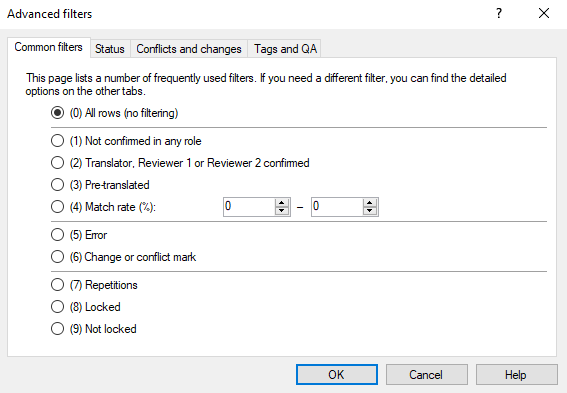
What can you do?
Go through the four tabs of the Advanced filters window, and choose the conditions you need. You can filter segments by their status, the comments and tags they contain, and their updated or synchronized state (in local copies of online projects). Here is a description of every group of settings:

- All rows (no filtering) radio button: Select this if you do not want to filter the segments for their status.
- Not confirmed in any role radio button: Jumps to segments that have any status but not confirmed by translator, reviewer 1 or reviewer 2.
- Translator confirmed, Reviewer 1 confirmed, or Reviewer 2 confirmed radio button: Jumps to segments that are Translator confirmed, Reviewer 1 confirmed or Reviewer 2 confirmed.
- Pre-translated radio button: Displays segments that were filled in through pre-translation and were not changed since.
- Match rate radio button: Displays segments that were originally pre-translated or filled in with a certain match rate. (Since then, they may have been edited or confirmed, but the match rate is still there.) Type two numbers in the boxes next to the radio button. For example, if you type 80 to 90, memoQ displays segments with matches between 80 and 90 percent.
- Error radio button: Displays segments that have errors that prevent the document from being exported.
- Change or conflict mark radio button: Displays segments that contain marks that indicate that the segment was changed by another user, or that the segment was modified by multiple users at the same time. Such marks appear when more than one users work on a document in an online project.
- Repetitions radio button: Displays segments that are marked as repetitions. This setting is different from the settings in the Filter by frequency section.
- Non-repetitions radio button: Displays segments that are not marked as repetitions.
- Locked radio button: Displays locked segments.
- Not locked radio button: Displays segments that are not locked.
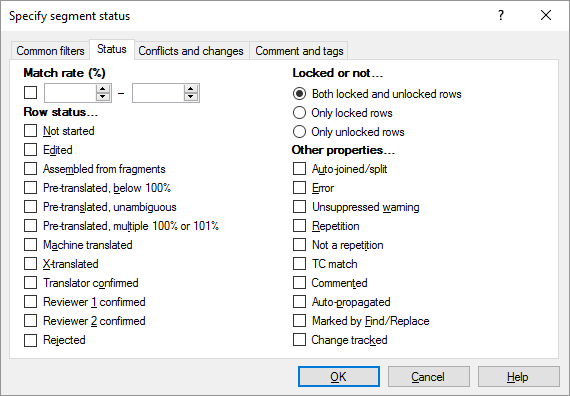
- Match rate (%): Displays every segment that was originally pre-translated or filled in with a certain match rate. (Since then, they may have been edited or confirmed, but the match rate is still there.) Check the check box before the two number boxes. Fill in the number boxes with two numbers. For example, if you enter 80 and 90, memoQ will give you segments that were originally pre-translated or filled in with a match rate between 80 and 90 percent.
- Row status:
- Not started: Check this to see every empty – not started – segments. This is the default setting.
- Edited: Check this to see every segment that was edited but was not confirmed.
- Assembled from fragments: Check this to see every segment put together from terms or other partial matches (fragments).
- Pre-translated, below 100%: Check this to see every segment that is below a100% match and comes from pre-translation.
- Pre-translated, unambiguous match: Check this to see every segment that has an unambiguous matchrate and comes from pre-translation.
- Pre-translated, multiple 100% or 101%: Check this to see every segment that is a 100% or 101% match and comes from pre-translation.
- Machine translated: Check this to see every machine translated segment
- X-translated: Check this to see every X-translated segment
- Translator confirmed: Check this to see every confirmed segment.
- Reviewer 1 confirmed: Check this to see every segment that was confirmed by the Reviewer 1 role.
- Reviewer 2 confirmed: Check this to see every proofread segment.
- Rejected: Check this to see all rejected segments.
- Locked or not:
- Both locked and unlocked rows: Includes all rows in the view, regardless of their locked or unlocked status.
- Only locked rows: Includes only the locked – not translatable – segments.
- Only unlocked rows: Includes only the not locked – translatable – segments.
- Other properties:
- Auto-joined/split: Check this to see auto-joined/split segments.
- Error: Check this to see errors that prevent the document from being exported.
- Unsuppressed warning: Check this to see warnings that were not set to 'ignore'. Warnings do not prevent the document from being exported.
- Repetition: Check this to see segments that is a repetition of another segment within the text.
- Not a repetition: Check this to see segments that are not repetitions of another segment within the text.
- Track Changes match: Check this to see every segment that has a track changes match.
- Commented: Check this to see every segment that contains a comment.
- Auto-propagated: Check this to see every segment that came from auto-propagation .
- Marked by Find/Replace: Check this to see every segment that was marked as a Find and replace hit.
- Change-tracked segment: Check this to see every segment where track changes were used and the original target segment was modified.
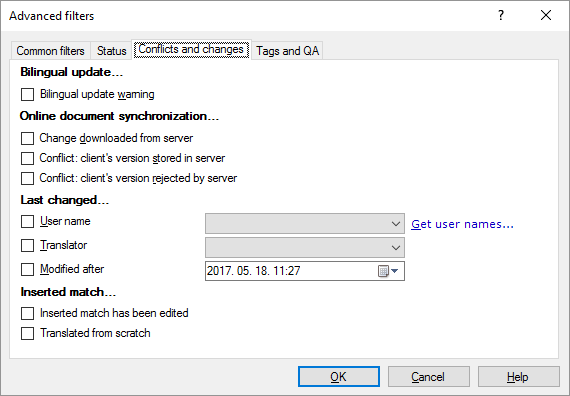
- Bilingual update section:
- Bilingual update warning check box: Gets segments that were modified when the document was updated from a bilingual file.
- Online document synchronization section:
- Change downloaded from server check box: Works in a checkout of an online project. Gets segments that were modified by another user, and were downloaded from the server.
- Conflict: client's version stored in server check box: Works in a checkout of an online project. Gets segments that were in conflict with another change from someone else, and your change was saved to the memoQ server.
- Conflict: client's version rejected by server check box: Works in a checkout of an online project. Gets segments that were in conflict with another change from someone else, and your change was rejected by the server. This means that the other user's version "won".
- Last changed section:
- User name text box: Type a user name here. Gets segments that were last modified by the user by that name. The name doesn't have to be one from the memoQ server. User names in documents may come from various other places, too.
- Translator text box: Type a user name here. Gets segments that were translated by the user by that name. The name doesn't have to be one from the memoQ server. User names in documents may come from various other places, too.
You can choose from the actual user names that are there in the document: Before you do that, click Get user names.
- Modified after date selector: Select a date and time here. Gets segments that were modified on this date and at this hour, or later.
- Inserted match section:
- Inserted match has been edited: Gets segments where a match was inserted, but the current translation is different from that match.
- Translated from scratch: Gets segments where a match was not inserted.
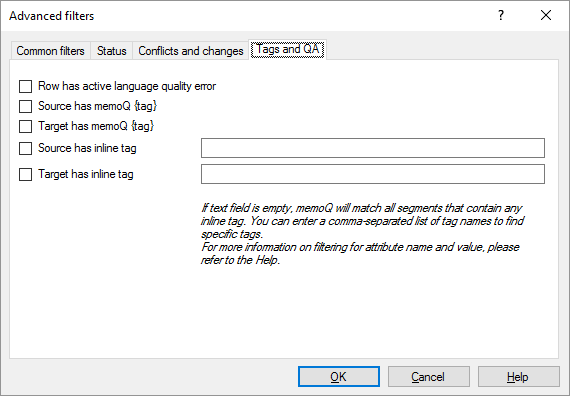
- Row has active language quality error check box: Gets segments where the reviewer added an LQA error.
- Source has memoQ {tag} check box: Gets segments where the source text includes an uninterpreted formatting tag.
- Target has memoQ {tag} check box: Gets segments where the target text includes an uninterpreted formatting tag.
- Source has inline tag check box and text box: Gets segments where the source text contains inline tags with a specific text. Type the text in the text box next to the check box. You can type several expressions, too, separated with a comma (,). memoQ gets segments where one of the expressions is in one of the inline tags on the source side.
- Target has inline tag check box and text box: Gets segments where the target text contains inline tags with a specific text. Type the text in the text box next to the check box. You can type several expressions, too, separated with a comma (,). memoQ gets segments where one of the expressions is in one of the inline tags on the target side.
- Row has active language quality error: Check this if you want to jump to those segments which have an LQA error indicated.
- Source has memoQ {tag}: Check this to restrict the view to segments where the source text includes an uninterpreted formatting tag.
- Target has memoQ {tag}: Check this to restrict the view to segments where the target text includes an uninterpreted formatting tag.
- Source has inline tag: Check the check box to restrict the view to segments where the source text contains inline tags with a specific text. Type the text in the box next to the check box. To type two or more expressions, separate them with commas (,).
- Target has inline tag: Check the check box to restrict the view to segments where the target text contains inline tags with a specific text. Type the text in the box next to the check box. To type two or more expressions, separate them with commas (,).
When you filter for inline tags, you can also check their attributes. In the expressions you type, you can specify a tag that has an attribute with a specific value. To check an attribute of a tag, type the name of the tag, then a > sign, and then the name of the attribute. If you also want to check the value of the attribute, type one more > sign, and then the value. Here are your options:
- tagname: Finds all tags that have tagname occurring in their names. Example: ingredient will find all of these:
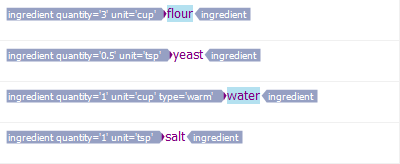
- tagname>attributename: Finds all tags that have a specific attribute, regardless of its value. Example: ingredient>type will find this:

- tagname>attributename>value: Finds all tags that have a specific attribute with a specific value. Example: ingredient>unit>cup will find these two:


- You can omit the name of the tag or the attribute. Thus you can find inline tags where the tag name is different, but they have the same attribute. Or, you can look for inline tags where both the tag name and the attribute name are different, but they share a common value. To find the above two segments, you can type this: >unit>cup, or this: >>cup.
- If the value contains spaces or commas, write them between quotes. Example: >author>name>"Technical Writer".
- Anything you write in the value part without quotes or with double quotes will be found in the text of the value. (In other words: memoQ doesn't check for a full match.) For example, ingredient>unit>c will find this:

- If you want an exact match, write the value between single quotes: ingredient>unit>'cup'.
- To write a double quote inside a value name, type it with a back slash: \". To write a single quote (apostrophe) inside a value name, type it (again) with a back slash: \'.
You can write relatively complex expressions here. memoQ warns you if your input has wrong syntax. The background of the text box turns light red if there is something wrong:

Using more than one condition
If you check two or more check boxes (even on different tabs), memoQ shows segments that meet any of those conditions. In formal logic, this is called an OR relation. Only one condition works differently: Locked or not is in an AND relation with all the other selected settings.
To use more conditions in an AND relation: Do the steps below for each condition.
- Click the Advanced filters
 icon.
icon. - Check one condition's check box.
- Click OK.
If no segments in the selected views or documents meet the conditions you choose, the view will be empty.
When you finish
To filter the rows, and return to the translation editor: Click OK.
To return to the translation editor, without filtering the rows: Click Cancel.